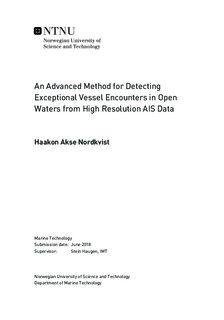An Advanced Method for Detecting Exceptional Vessel Encounters in Open Waters from High Resolution AIS Data
Master thesis
Permanent lenke
http://hdl.handle.net/11250/2564476Utgivelsesdato
2018Metadata
Vis full innførselSamlinger
- Institutt for marin teknikk [3396]
Sammendrag
This thesis is based on the assumption that AIS is underutilised for risk assessment models. The proposed model estimates the frequency of exceptional encounters between ship pairs whichcan give an indication of risk. An advantage of the proposed model is the possibility of identifying periods with higher frequency of encounters, it can also find frequencies for subsets of flag states, vessel types or both.
The model relies on a ship domain approach to find potential exceptional encounters, whichis well established in the navigational risk research community. From this set of encounters rate of turn is estimated before and after closest point of approach to sort out exceptional encounters where the rate of turn is larger. This is a less documented approach for quantifying the presences of risk in an encounter between two vessels. It is based on the rules of the sea where a vessel required to give way must do so early and substantial in the perspective of the other vessel.
The model was applied on an area of Vestfjorden in a four year time period from 2013 to2016. The model found 707 ship pairs where one or both vessels had their ship domain violated. Using a threshold of 70 deg/min for rate of turn 381 encounters are classified as exceptional.
Normalizing encounters for distance and trips shows that certain groups have far too highfrequency. It is apparent that the model has problems handling encounters between two fishingvessels. Further it is discovered that noise in the AIS data are contributing to rate of turn being over estimated resulting in fairly straight tracks having high values. This is particularly evident from a ferry route where a significant number of head-on encounters without course alterations are registered as exceptional. Filtering out these two types of encounters gives a normalized frequency that are similar across the dataset.
It is concluded that the hybrid solution for estimating frequency of exceptional encounterswhere traditional ship domain theory and evasive maneuver detection combined have potentialto become a solid risk assessment tool with further development.
